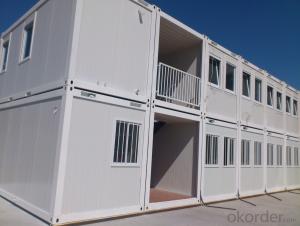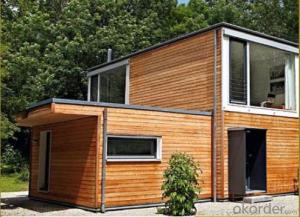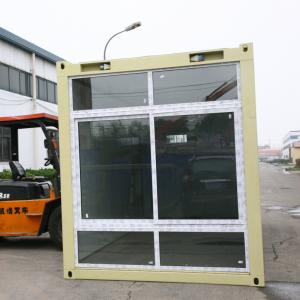Modular Container Home & house
- Loading Port:
- Tianjin
- Payment Terms:
- TT OR LC
- Min Order Qty:
- -
- Supply Capability:
- 20000 Set set/month
OKorder Service Pledge
OKorder Financial Service
You Might Also Like
Modular Container Home & house
| Item | Description |
| Name | Modular Container Home & house |
| Structure |
|
| Wall Panel |
|
| Insulation |
|
| Electrical |
|
| Door |
|
| Window |
|
| | |
- Q:Are container houses suitable for Airbnb or vacation rental investments?
- Airbnb or vacation rental investments can greatly benefit from the use of container houses. These innovative structures provide a distinct and trendy lodging experience that appeals to a wide range of guests. The modern and sleek designs of container houses have gained popularity among travelers seeking a unique stay. There are several advantages to investing in container houses for Airbnb or vacation rentals. Firstly, they offer cost-effectiveness as containers can be purchased at a lower price compared to traditional homes. This allows investors to save on initial investment costs and potentially earn higher returns on their investment. Secondly, container houses provide a high level of customization. They can be modified and designed according to the preferences and needs of the target market. This flexibility allows owners to create stylish and one-of-a-kind living spaces, which can be a significant selling point for potential guests. Moreover, container houses are environmentally friendly as they repurpose unused shipping containers and reduce waste. This aspect can be particularly appealing to environmentally conscious travelers who prioritize sustainable accommodation options. In terms of practicality, container houses require relatively less maintenance compared to traditional homes. They are made of durable materials that are resistant to various weather conditions, saving owners both time and money on upkeep and repairs. However, it is important to consider that container houses may not be suitable for all locations or markets. Some areas may have strict regulations or zoning restrictions that limit the potential of container houses as vacation rentals. Prior research and understanding of local regulations is crucial before investing in container houses for Airbnb or vacation rental purposes. In conclusion, container houses are a viable investment option for Airbnb or vacation rentals. Their unique design, cost-effectiveness, customizability, eco-friendliness, and low maintenance requirements make them an attractive choice for both owners and guests. However, it is essential to carefully consider local regulations and market demand before making any investment decisions.
- Q:Can container houses have multiple floors?
- Yes, container houses can have multiple floors. Container houses are versatile and can be stacked on top of each other to create multiple levels. This allows for the efficient use of space and the ability to accommodate larger families or provide additional living or working areas. However, it is important to ensure that the structure is properly reinforced and designed to support the weight of multiple floors to ensure safety and stability.
- Q:Can container houses be insulated?
- Yes, container houses can be insulated. In fact, insulation is an important aspect of container house construction. Since shipping containers are made of metal, they have a tendency to conduct heat and cold, making the interior temperature uncomfortable. However, by adding insulation to the walls, roof, and floor of a container house, the thermal performance can be greatly improved. There are various insulation options available such as foam, fiberglass, or even natural materials like straw bales. Additionally, insulation can help in reducing energy consumption for heating or cooling, making container houses more energy-efficient and cost-effective in the long run.
- Q:Can container houses be designed with a home workshop or craft space?
- Yes, container houses can definitely be designed with a home workshop or craft space. One of the main advantages of container houses is their versatility and flexibility in design. With proper planning and layout, it is possible to incorporate a designated area for a home workshop or craft space within the structure of a container house. Container houses can be modified and customized to cater to specific needs and preferences. The interior layout can be designed to include a separate room or section that can serve as a workshop or craft space. This area can be equipped with workbenches, storage shelves, tool racks, and other necessary equipment based on the specific requirements of the homeowner. Some container houses even feature double-height ceilings, which can be advantageous for accommodating larger equipment or machinery. The containers can be interconnected or expanded to create a larger workspace if needed. Windows and skylights can be strategically placed to allow ample natural light into the workshop or craft space, enhancing productivity and creativity. Additionally, container houses are known for their energy efficiency and insulation properties. This ensures a comfortable working environment, regardless of the weather conditions outside. Proper insulation, ventilation, and heating or cooling systems can be installed to maintain suitable temperatures and airflow within the workshop or craft space. In conclusion, container houses can be designed with a home workshop or craft space, making them an excellent choice for individuals who want to combine their living space with their hobbies or professions. The design possibilities are vast, and with careful planning and customization, a container house can provide a functional and inspiring workspace for creative pursuits.
- Q:Are container houses affordable?
- Container houses are typically regarded as more affordable than traditional houses. The expense of constructing a container house can differ based on factors like size, design, location, and customization level. Nevertheless, in general, container houses tend to be more economical because the primary structure is already established, resulting in reduced construction time and labor expenses. Moreover, shipping containers are easily accessible and can be obtained at relatively inexpensive prices. Furthermore, container houses have lower maintenance costs due to their durable and weather-resistant characteristics. In summary, container houses provide a more affordable housing alternative for individuals seeking an alternative to conventional homes.
- Q:Are container houses suitable for college student housing?
- Container houses can be a suitable option for college student housing for several reasons. Firstly, container houses are affordable and cost-effective compared to traditional housing options. College students often have limited budgets, and container houses offer a more economical alternative that can help ease the financial burden. Secondly, container houses are portable and can be easily moved to different locations. This flexibility is especially beneficial for college students who frequently change their living arrangements, such as moving between semesters or studying abroad. The ability to transport container houses ensures that students can have a stable and comfortable living space no matter where they are studying. Furthermore, container houses can be customized and designed to accommodate the specific needs of college students. They can be divided into separate rooms or shared spaces, providing students with privacy and a sense of personal space. Additionally, container houses can be equipped with essential amenities like electricity, heating, and plumbing, ensuring that students have a comfortable living environment. Another advantage of container houses for college student housing is their sustainability. These houses are often made from recycled materials, reducing the environmental impact and promoting eco-friendly living. This can resonate well with college students who are increasingly conscious about their carbon footprint and want to live in a more sustainable manner. However, it is important to consider a few factors before deciding if container houses are suitable for college student housing. The size of the container may be limited, and it may not have enough space to accommodate large groups of students. Additionally, the availability of land or suitable locations to place container houses near college campuses may be a challenge. In conclusion, container houses can be a suitable option for college student housing due to their affordability, portability, customization options, and sustainability. However, it is important to carefully consider the specific needs and circumstances of college students before implementing container houses as a housing solution.
- Q:Are container houses considered sustainable housing options?
- Yes, container houses are considered sustainable housing options. Container houses are made from repurposed shipping containers, which reduces the demand for new construction materials and helps to reduce waste. By using these recycled containers, fewer resources are consumed and less energy is required compared to traditional construction methods. Additionally, container houses can be designed to be energy-efficient by incorporating insulation, solar panels, and other eco-friendly technologies. They can also be easily transported, allowing for flexibility and minimizing the need for new construction in different locations. Overall, container houses offer a sustainable alternative to traditional housing options.
- Q:Can container houses be built with a traditional living room setup?
- Yes, container houses can definitely be built with a traditional living room setup. Container houses are highly customizable and can be designed and constructed to accommodate various floor plans and interior layouts, including a traditional living room setup. The containers themselves can be modified to have large open spaces, allowing for the inclusion of a living room area with comfortable seating, entertainment systems, and traditional furniture like sofas, coffee tables, and TV stands. Additionally, container houses can be expanded or connected to create larger living spaces, providing even more flexibility in designing a traditional living room setup. With the right planning and design, container houses can offer all the comforts and functionality of a traditional home, including a cozy and inviting living room.
- Q:How do container houses handle the need for efficient space utilization?
- The need for efficient space utilization is effectively addressed by container houses, as they maximize the available space within the container. These innovative homes are constructed using shipping containers, which are specifically designed for efficient transportation of goods. To accommodate essential living spaces, such as bedrooms, bathrooms, kitchen, and living areas, the interior of the container is modified accordingly. Container houses make great use of vertical space by incorporating multi-level designs or utilizing loft spaces. This enables the creation of separate rooms or areas within the limited floor area of the container. Additionally, clever storage solutions are implemented to fully utilize every nook and cranny. Built-in cabinets, shelves, and foldable furniture are commonly utilized to save space and maintain an organized interior. Another effective approach to efficient space utilization in container houses is the use of flexible and multi-functional furniture. Many container homes feature convertible furniture that serves multiple purposes. For instance, a dining table can be folded down to provide additional workspace, or a bed can be concealed within a wall during the day to free up floor area. Furthermore, container houses often incorporate outdoor living spaces, such as decks or rooftop gardens. These outdoor areas offer additional usable space and can be utilized for various activities, including dining, relaxation, or gardening. By extending the living area to the outdoors, container houses compensate for the limited interior space. In conclusion, container houses utilize creative design strategies, efficient storage solutions, and versatile furniture to optimize space utilization within the confined structure of a shipping container. By carefully considering the layout and functionality of each element, these houses provide comfortable and functional living spaces while making the most of the available area.
- Q:Can container houses be designed to have a wheelchair ramp?
- Yes, container houses can definitely be designed to have a wheelchair ramp. The beauty of container houses is that they can be customized and modified according to the specific needs and requirements of the inhabitants. The design and installation of a wheelchair ramp can be seamlessly integrated into the structure of a container house, ensuring accessibility for individuals with mobility challenges. There are various ways in which a wheelchair ramp can be incorporated into a container house design. One option is to have a ramp built on the exterior of the house, leading to the entrance. This can be achieved by creating a gradual slope or by installing a foldable ramp that can be extended and retracted as needed. Alternatively, the interior of the container house can also be adapted to include a ramp. This can be achieved by modifying the floor plan to have a gentle incline or by installing a platform lift that can raise or lower the wheelchair to different levels within the house. In both cases, it is important to ensure that the ramp meets all safety standards and regulations. This includes considering factors such as the width, length, and gradient of the ramp, as well as the use of handrails and non-slip surfaces. Ultimately, container houses offer great flexibility when it comes to design and customization. With the right planning and modifications, wheelchair ramps can be easily incorporated into the overall design of a container house, allowing for easy accessibility and enhanced quality of life for individuals with mobility challenges.
1. Manufacturer Overview |
|
|---|---|
| Location | |
| Year Established | |
| Annual Output Value | |
| Main Markets | |
| Company Certifications | |
2. Manufacturer Certificates |
|
|---|---|
| a) Certification Name | |
| Range | |
| Reference | |
| Validity Period | |
3. Manufacturer Capability |
|
|---|---|
| a)Trade Capacity | |
| Nearest Port | |
| Export Percentage | |
| No.of Employees in Trade Department | |
| Language Spoken: | |
| b)Factory Information | |
| Factory Size: | |
| No. of Production Lines | |
| Contract Manufacturing | |
| Product Price Range | |
Send your message to us
Modular Container Home & house
- Loading Port:
- Tianjin
- Payment Terms:
- TT OR LC
- Min Order Qty:
- -
- Supply Capability:
- 20000 Set set/month
OKorder Service Pledge
OKorder Financial Service
Similar products
New products
Hot products
Hot Searches
Related keywords

























